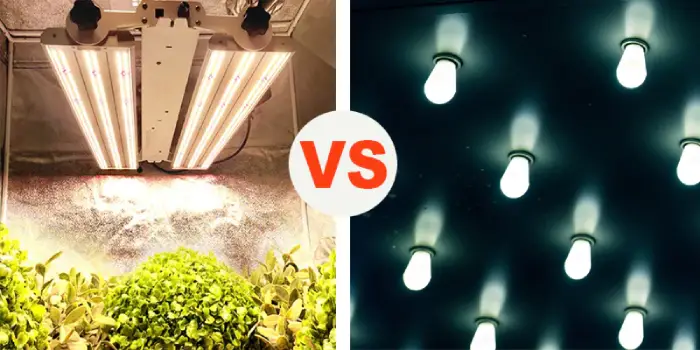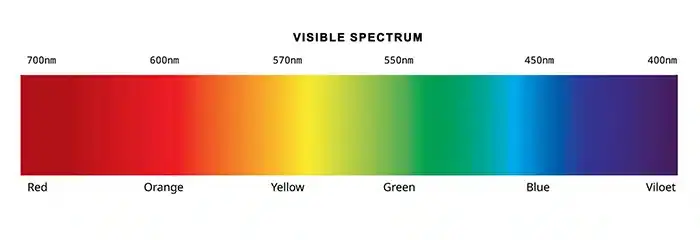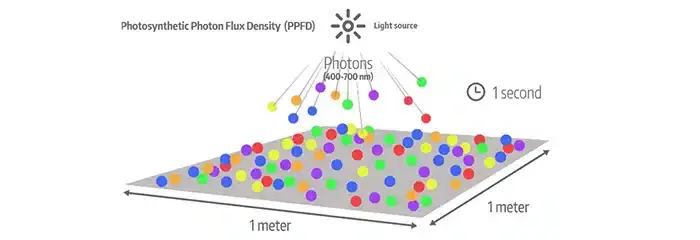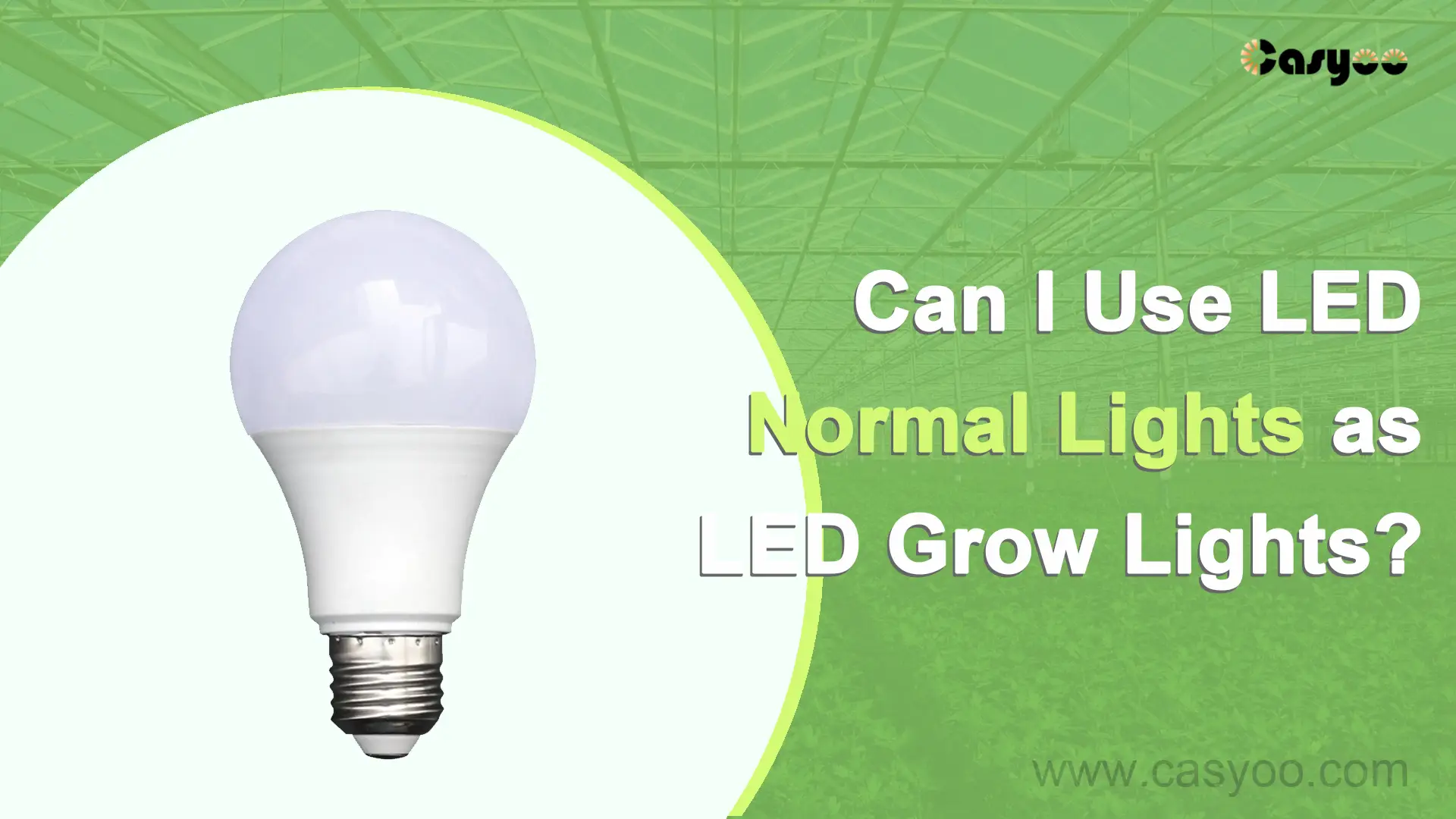Yes, your plants are certain to grow, more or less. However, they lack the specific spectrum and intensity for plant growth, thus using LED regular lights as LED grow lights is unlikely to result in healthy crops in the long term.
So why don’t I recommend using regular light bulbs? This blog will delve deeper into the subject. What is exactly the difference between regular lights and grow lights?
LED Grow Light vs Regular Light: What Are the Main Differences?

Are grow lights different from regular lights? Yes. Although they employ the same technology, LED lights and LED grow lights have different applications. LED normal lights are frequently utilized in residences or businesses to illuminate surroundings. On the other hand, LED grow lights emit particular light spectra to promote plant photosynthesis.
Sounds vague? We have listed the following five points that LED grow lights differ from normal lights:
Light Spectrum

Countless studies have proven that the following colors are ideal for plant growth. They are red, blue, green, infrared, and ultraviolet.
- Red and blue light: The two are the most significant to plants among these colors. Blue light enhances the sturdy of the stem and root, whereas red light promotes flowering and budding. Grow lights emit a lot of blue light to get seeds started, as this is the most crucial element in the early stages of growth. later, they provide red light to encourage plant development when it’s time for them to blossom.
- Ultraviolet light: It aids in sterilizing and directs plants toward flowering.
- Green light: Grow lights have less green since green is not as popular with plants. However, they help lower-positioned leaves absorb light more efficiently.
- Infrared light: It is not visible to the eyes. Although it is not as powerful as red and blue, it will nevertheless penetrate deeper through the leaf and encourage cell development, resulting in a greater number of leaves and larger branches over time.
Regular LEDs, on the other hand, mostly emit white and yellow light. They help plants somewhat, but not as much as grow lights, which are designed specifically to promote plant development.
Light Intensity

LED regular lights seem to us bright enough. So we naturally reckon that they provide enough intensity for crop growth. This is not true. The intensity of normal light is measured by lumen, which is a unit we use to quantify the amount of visible light that human eyes can see.
When it comes to plants, PPFD is used to measure the amount of photosynthetic light that plants receive. While Normal bulbs may appear bright, they often have a lower PPFD than grow lights. Therefore, grow lights are the best option for indoor plant cultivation because of their high light intensity.
Heat Emission
LED grow lights emit heat with remarkable efficiency, even with their high power output. With the least amount of heat waste possible, they are designed to provide the light spectrum that plants require. Many LED grow lights have passive cooling systems to make sure that the heat emission is safe for both the indoor grower and the plants. This is very different from traditional grow lights, such as HPS grow lights, which can produce a lot of heat.
Regular household LED lights also produce less heat. But they will cause heat buildup, thus requiring a ventilation system to dissipate the heat from the grow space.
Power Consumption
Grow lights often have a higher wattage than conventional bulbs because of their full spectrum. This means more power consumption. In spite of this, they are more energy-efficient than standard lights; they can use up to 50% less, operate cooler, and produce a more effective light spectrum.
Energy Efficiency
The purpose of regular LEDs is illumination. LED grow lights are designed to minimize power usage and meet the unique light spectrum requirements of plants. This indicates that although a grow light may use more energy than a standard LED light when operating at maximum capacity, the benefit it provides to plant growth outweighs the energy consumption per watt.
Furthermore, many current grow lights can adjust light intensity according to the time of day or the growth stage of the crops, further maximizing power usage. While grow lights may require more power initially, their specialized design and efficiency might result in more sustainable energy use over the long run.
Lifespan
LED grow lights work longer than regular lights. Numerous top-notch LED grow lights, like Casyoo LED grow lights, have lifespans between 50,000 and 100,000 hours, guaranteeing several years of reliable operation.
On the other hand, regular LEDs, designed for home usage typically have a 25,000–50,000 hour lifespan. The lifespan of these bulbs can be shortened by the repeated on-and-off cycles that are common in domestic settings, despite the seemingly respectable numbers.
Are There Any Plants That Can Work Well with LED Regular Lights?
can a regular light bulb be used to grow plants? It depends. Your plants receive some wavelengths of PAR light from regular LED lights. They won’t work well for all kinds of plants, though. Nevertheless, certain plants can endure low light levels.
Plants that grow naturally beneath trees don’t need a lot of light. Your standard LED lights might be beneficial for those plants. You can try using regular LED lights for plants if any of the following plants aren’t receiving enough sunlight.
Highly shade-tolerant plants (best for regular LED light)
- Snake Plant
- Peace Lily
- Parlor Palm
Moderately shade-tolerant plants (can adapt to normal LED light)
- Devil’s Ivy
- Spider plants
- Philodendron
Low shade-tolerance plants (may require supplemental grow lights)
- Bromeliads
LED Grow Light vs Regular Light: Which One Should You Choose
You can use regular lights to grow plants in the short term or plants that need a low level of light. You cannot, however, guarantee that your plants will grow healthily. After all, plants require specific light spectra for photosynthesis, and standard LED lights do not emit enough color. Consequently, you need to purchase grow lights.
Choose LED grow lights if you want:
- Full-spectrum and adjustable light (red, blue, UV, IR)
- Higher PPFD (light intensity)
- Energy-efficient operation
- Faster growth, better yields, and healthier plants
- Long lifespan (50,000–100,000 hours)
Regular LED lights are only suitable for:
- Short-term or supplemental lighting
- Low-light plants
If the higher cost of the grow lights is deterring you from purchasing them, keep in mind that their return on investment is quick. Plants under grow lights will produce flowers and fruits more quickly. Additionally, you will harvest more crops. Check our collection and pick one!




